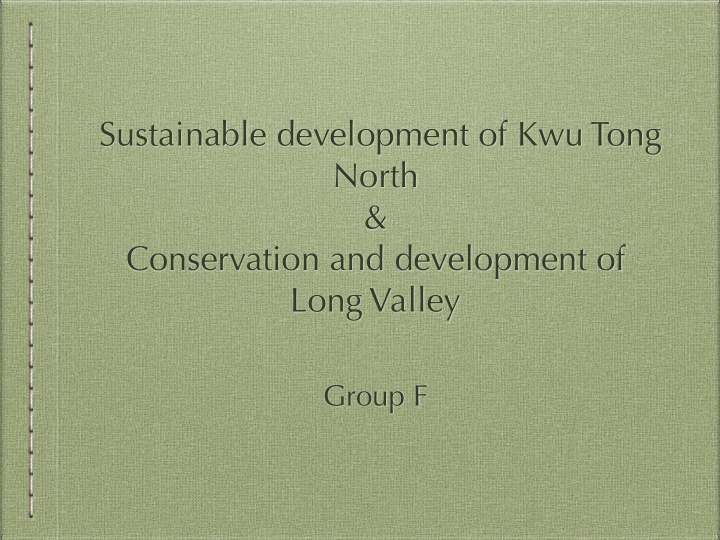



Sustainable development of Kwu Tong North & Conservation and development of Long Valley Group F
What we discovered at Long Valley Abandoned Farm Dry Agriculture wet agriculture
Fish Pond wetland Bloodworm pond
egret black-faced spoonbill yellow-breasted bunking
High ecological value more than 210 bird species found at Long Valley, while there are ~400 found in HK native agriculture
Blueprint of Kwu Tong North
reserve long valley as a nature park of 37.2 hectares accommodate a total population of about 176900 other infrastructure
Sustainable Development
What we concern about the development project
Alternative Plan 4000 hectares of unused government land (952 hectares of residential use) 90 hectares of residential area provided by the project
Disturbance of habitat at Long Valley Construction of new city will affect the air quality at Long Valley New population will cause pollution, which reduce the no. of animals inhabited. Tall buildings affect birds flight paths Cars cause air pollution
Blurred boundary of natural park unexampled details not given
Agricultural land used for other purposes Dumping (both legal and illegal) of construction wastes Container yard (貨櫃場) Construction of Small Houses (丁屋) Use of city planning to restrict the development on land of high ecological value is not reliable.
Our Suggestions
leave Kwu Tung North as it is in order to avoid irreversible damage to environment resources for nature education land resumption carried out by government cooperation between farmers and green organizations
Resources for nature education a key site for students and educators to learn about our environment first-hand eco-tours clear concept of conservation
Sustainable Agriculture protect and improve the natural environment, the social and economic conditions of local communities safeguard the health and welfare of all farmed species
Farming method organic farming no chemical fertilizer or pesticide avoid large-scale machinery avoid monoculture grow seasonal fruit and vegetables
Aerobic Composting eg. Ma Po Po Community Farm in Ma Shi Village reuse plant litter from horticultural and agricultural activities and animal manure lessen waste footprint
Crop rotation Fallowing Agroforestry
local consumption food mileage local economy, employment opportunities self-reliant
End
Recommend
More recommend